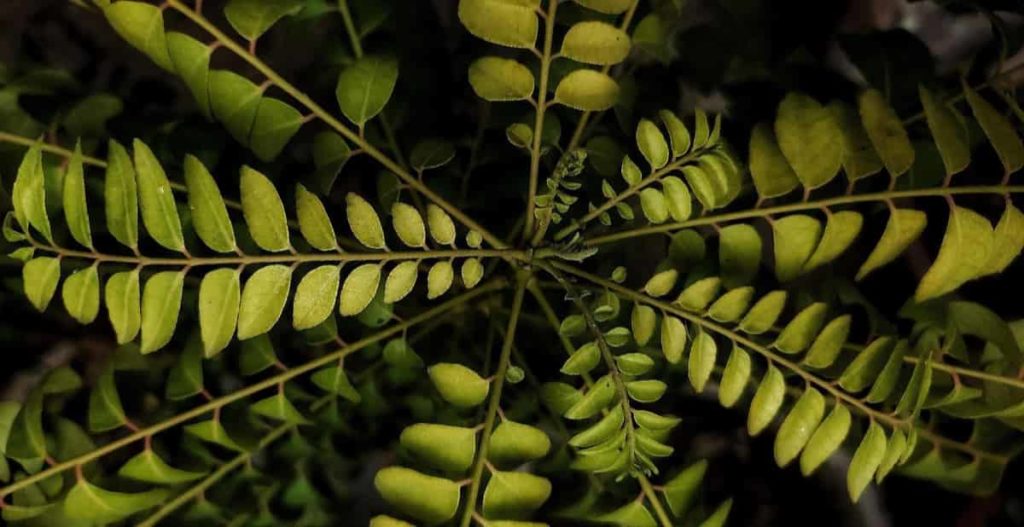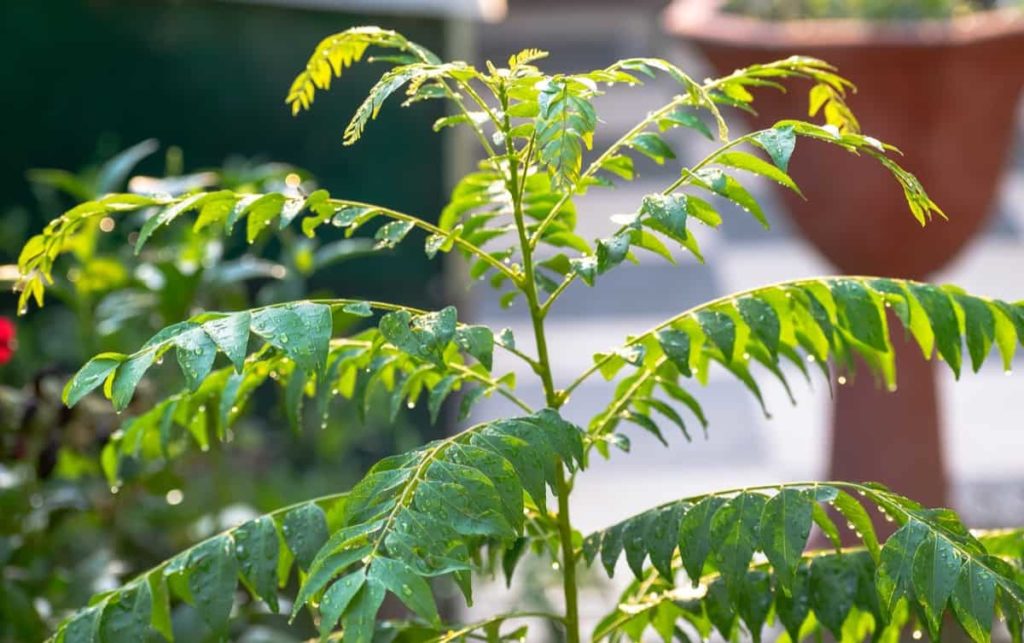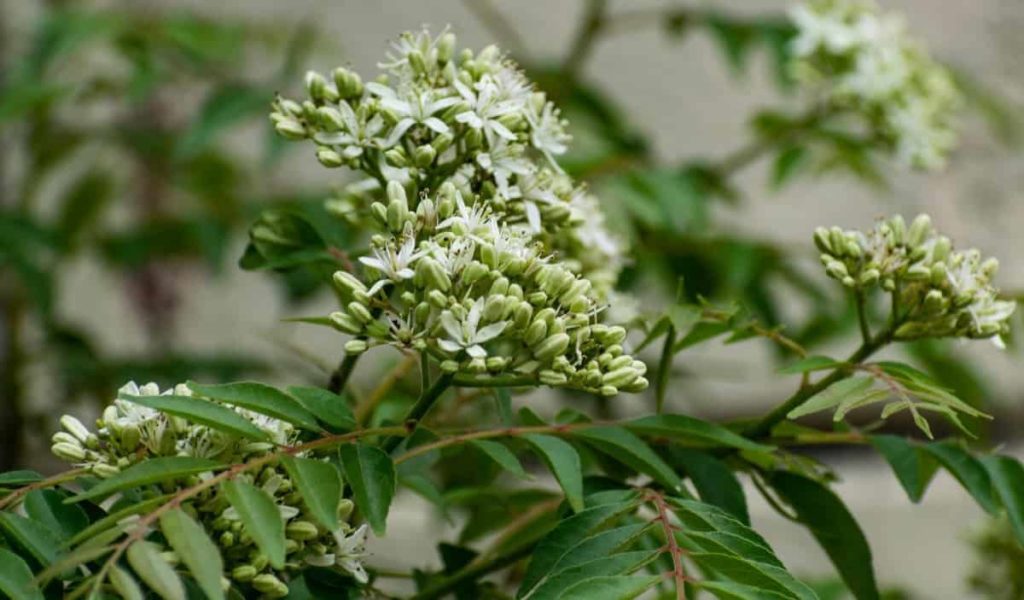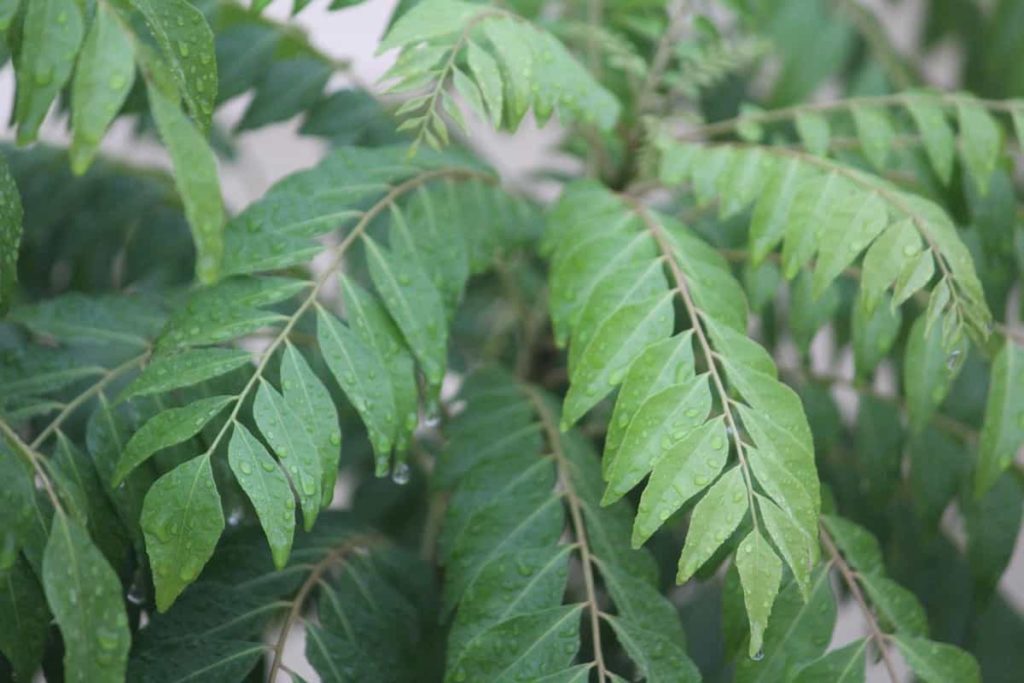The Curry Leaf plant is known for its highly aromatic leaves used worldwide to add a uniquely pungent flavor to dishes. The Curry Leaf tree is a tropical/subtropical plant from India. This requires a warmer climate to grow. Curry leaves have the strongest taste and aroma when fresh. You can use Curry Leaves in soups and sauces and also dry the leaves and crush them for use. Growing Curry Leaf trees is the best way to provide a consistent supply of this flavorful herb.

How to grow Curry Leaves from seed to harvest,
How long does it take to grow the Curry Leaf plant from seed?
- The Curry Leaf tree is a small evergreen tree that grows 3 to 6 meters in height. It has aromatic compound leaves with about 12 dark green leaves.
- Placing the Curry Leaf plant seeds in a damp paper towel for a few days before putting them in the soil will speed up the growth process. Next, you should cover the Curry Leaf seeds with soil and place them in a warm place. The seeds will germinate within 10 to 15 days. Note that the root may take longer if the temperature is low.
- Curry Leaf plant may take up to two years to set up, so you can start harvesting the leaves regularly. Buy fresh, dried seeds for the best opportunity to grow. Old seeds don’t grow well.
Can Curry leaves grow from seeds?
- You can grow Curry Leaf plants from cuttings or seeds. The seed is the fruit’s pit and can either be cleaned or the whole fruit can be sown. Fresh seeds show the highest rate of germination. Sow the seeds in the soil and keep them moist but do not keep them wet. Curry Leaf plant seeds will need a warm area of at least 20°C to germinate. Growing a Curry Leaf tree from seeds is not an easy task as germination is fickle. Other methods are more consistent.
- Propagation from cuttings is the easy one. Using sharp pruners or knives, take a three-inch portion of a healthy stem with a few leaves. Remove the leaves from the bottom inches below the cutting. If you keep it warm and moist, cutting will root in about three weeks. Growing a Curry Leaf tree in a home garden is only appropriate in areas without freezes.
Can you grow curry leaves indoors?
- The Curry Leaf plant is frost tender but can be grown indoors. You should plant the tree in a well-drained pot with a good potting mix and place it in a sunny area. You should feed it weekly with a diluted solution of seaweed fertilizer and trim the leaves as needed.
- There is no problem planting curry leaves indoors, as no side effects are observed. Instead, the growth of plants indoors can be very beneficial.
How can I make curry leaves grow faster?
- If you want to grow your Curry Leaf plant faster, apply seaweed fertilizer every 15 days. Seaweed or kelp fertilizers contain more than 60 trace minerals from the ocean. Not only that, but they are also valuable as a growth stimulant due to the presence of multiple growth hormones.
- Epsom salt contains both magnesium and sulfur, which is best for the growth of Curry Leaf plants. It also increases the production of chlorophyll in the leaves and gives the leaves a green color.
- Dissolve about one teaspoon of Epsom salt and magnesium sulfate in 1 liter of water and then feed the Curry Leaf plant when dried. Give Epsom salt every three months. Your Curry Leaf plant will grow very quickly and very well.
In case you missed it: 13 Common Curry Leaf Plant Problems: How to Fix Them, Solutions, and Treatment

Does curry plant need full sun?
- You should plant Curry Leaf plant in rich, well-drained soil in full sunlight or partial shade. If it is grown outdoor, it should be located in an area that does not get too much air.
- The Curry Leaf tree thrives in full sunlight. Place in the absolute sunny part of your garden for the best results. With proper lighting and care, the tree will produce good leaves.
- The plant grows in full sunlight or partial shade but does not tolerate full shade or cold temperatures. Most well-drained soils are suitable. Plant Curry Leaf plant seeds indoors or directly in the ground in early spring when you’re sure all the risk of frost has passed. The seeds germinate best at a temperature of 17 to 23°C.
- This plant will need full sun to thrive, but this full exposure should be used before you give it for more than six hours a day. This is especially true when the temperature reaches more than 37°C as the leaves can have sunburn.
How fast does a Curry Leaf tree grow?
- Once established, the Curry Leaf plant doesn’t need much attention. However, it takes about two years for young plants to establish themselves completely.
- A fast-growing Curry Leaf tree is a small evergreen shrub or tree that can reach anywhere from six to 20 feet long. The most prominent part of the Curry Leaf tree is its fragrant, spicy leaves, which consist of many leaflets.
- The standard varieties should be about six feet long in two years, and you can start regularly harvesting at that time. Dwarf and miniature varieties take a little longer to reach harvestable sizes of about half their mature height, with smaller plants taking up to five years.
Should I cut back my curry plant?
- You should prune your Curry Leaf plant when it reaches at least 12 inches long. Pruning will help to remove the branch of the Curry Leaf plant, become bushy, and avoid becoming leggy. It is better to prune branches with flowers from mature plants because flowers will take the energy of plants away from growing more leaves.
- When your Curry Leaf plant is six months old, it’s time to start pruning. Pinch or prune two branches to encourage bushy growth when a healthy seedling has formed six or more branches with several developed leaves.
Why is my Curry Leaf plant flowering?
- In two years, the Curry Leaf plant will start producing very small flowers at the tip of the branch. If it is allowed to grow on the plant, these flowers will produce seeds at the end of the season.
- When the flowers mature and turn into fruits, the plant diverts most of the energy into nurturing these flowers. Therefore, unless you want these seeds, it is better to cut the flowers; otherwise, the plant’s growth slows down.
How often do you water a Curry Leaf plant?
- You should never over-water your Curry Leaf plant, as it kills them fast. In summer, water the plant every 2 to 3 days and keep an eye on small mites. Water is needed only every week in the fall.
- You should only give minimal water when the top of the soil is completely dry. You’ll need to water more often in spring and summer when they start to grow.
- During the spring and less hot months of the year, it is a plant that will grow well with water once a week. However, water may be needed every day during the hot summer months to ensure that the soil is not too dry in the summer.
- You should give water to the Curry Leaf plant well but frequently. Let the soil dry between the water. If the plant gets water through the rain, delay watering the plant until the soil above feels dry.
- For best results, grow in full sunshine and keep the temperature above 4°C. If grown in warmer conditions with higher light intensity, curry leaves will experience fewer winter resting periods. During winter rest, do not significantly keep the plant too wet if the leaves have fallen.
In case you missed it: How to Grow Curry Leaves from Seeds at Home: Steps, and Seed Germination Process

Is rice water good for Curry Leaf plant?
- Rice water is better than tap water and helps plants grow much better. It is all mixed in water and thus can benefit plants in many ways. It also has starch that promotes healthy bacteria that grow in the rhizosphere.
- Watering plants with fermented rice water is one of the best remedies. Dilute the fermented rice water twice the amount of normal water and spray it on the leaves to eliminate pests. Rice water helps increase the growth of tender leaves.
What do I feed my curry plant?
- Apply a blood meal application in the spring, followed by monthly seaweed or fish fertilizer applications. The Curry Leaf plant also responds positively to homemade fertilizers such as buttermilk, rice water, Asafoetida, and eggshells, which can be applied weekly.
- Diluted yogurt or buttermilk is a good home fertilizer for Curry Leaf plants. You need to allow the soil to dry completely before watering the plant. In winter, the plant becomes inactive, so apply less water. Buttermilk is very high in nitrogen, which the Curry Leaf plant needs.
- The Curry Leaf plant needs high amounts of nitrogen to grow lush leaves. Fish emulsion is an organic, liquid fertilizer with a high nitrogen value but also contains some phosphorus and potassium.
Why are my curry leaves curling up?
- If you notice that the leaves of your Curry Leaf plant are curled down or bent, chances are the light is the culprit. Try to give your Curry Leaf a full day of sunlight to see if they start to perk up.
- Heat stress causes rapid evaporation, so plants curl up to conserve moisture. Plants very close to high-intensity lights are subject to heat stress, but this can be a problem in any room where the temperature is consistently above 26°C. Set up fans to blow hot air and bring cool fresh air.
Is eggshell good for Curry Leaf plant?
- Eggshells have high calcium content, which helps grow new leaves. They also help develop a better root system in the Curry Leaf plant. Crush two to three eggshells and add them to the base of the plant. You should mix well in the top 2 inches of soil.
- Crushed eggshells provide calcium to the Curry Leaf plant, one of the important nutrients for plant well-being. Calcium promotes vigorous growth, green leaves, and a strong root system. Eggshells are one of the best homemade fertilizers for a Curry Leaf plant.
In case you missed it: Growing Strawberries from Seed to Harvest: A Complete Planting Guide for Beginners

Where should I plant a Curry Leaf tree?
- The Curry Leaf Tree is tropical to the subtropical tree but does well in temperate areas and requires rich, well-drained soil in a warm shelter position in the garden. Keep it in a large container when the cold climate increases and transfer it to a warm position in the winter. They are frost tender.
- The best growing conditions for a Curry Leaf tree are in full sunshine for light shade, and it’s not fussy about soil type or even very specific about drainage. Anywhere you can grow a Curry Leaf tree, including districts with light frosts and cold winters.
How do I protect my curry leaves from insects?
- Spraying plants with 5% Neem seed kernel extract or 0.03% percent azadirachtin is an eco-friendly method. Applying fish oil rosin soap to one part of 25 parts of water will be extremely effective against sucking insects. In case of a severe attack, malathion should be sprayed at 0.05%, carbaryl at 0.1%, acephate 75SP at 1 gram per liter, and triazophos at 2.5 ml per liter.
- You should start applying neem oil spray every two weeks. Neem oil helps control harmful pests and protects plants from fungal and bacterial infections. Once a month, hose the bottom of the plant with sharp water spray.
How do you propagate curry leaves?
- You can grow a new Curry Leaf plant from a fresh cutting off a matured large curry leaf plant. Push the stem 2 to 3 inches deep in the potting mix. Make sure there are at least 2 to 3 leaves on the cutting so that it can grow easily. Water the soil until you see it coming out of the drainage holes.
- Dip the cutting in powder if you’re using a rooting hormone. Carefully put the Curry Leaf plant cutting into a hole in the soil so that the powder does not scratch the stem. Fill the hole with cutting and press firmly on the soil around the Curry Leaf stem to ensure it stays in place.
- You should immerse the bare stem into the medium and moist thoroughly. Cutting will root in about three weeks if you keep it warm and moist. Growing a Curry Leaf tree in a home garden is only appropriate in areas without freezes.
How do curry leaves grow in winter?
- Keep them in the sun during the day and move indoors before it gets dark and colder. Add warm water instead of cooling down. Occasionally sprinkle saltwater on the leaves to wash dirt, bugs, and mites or molds, if any. Make sure there is enough light wherever you keep them indoors.
- When autumn begins to cool down, it’s time to help the Curry Leaf plant prepare for inactive time indoors during winter. Move the pot to the full sun point, where it gets 6 to 8 hours of direct sunlight. If needed, make the Curry Leaf plant in a pot again in the early autumn.
In case you missed it: Curry Leaves Gardening For Beginners, How to Start

What kind of soil is good for Curry Leaf plant?
- The Curry Leaf plant needs cow dung or well-drained soil combined with organic manure and river sand. The best time to sow the Curry Leaf plant is from February to March. Curry Leaf plants are grown from both seeds and cuttings. This plant takes 1 to 2 years of continuous growth with healthy and fragrant leaves.
- Curry Leaf plants prefer to live on moist, well-drained soil. It should have a slightly acidic pH. You should add half the amount of organic matter such as compost or animal manure to help plant growth.
Can curry leaves grow in pots?
- Experts say that it is easy to grow Curry Leaf plants in pots. You can fill pots with soil, sand, and cow dung or use a store-bought organic soil mix. Plant the curry leaves, and don’t forget to water them daily. The pot should be placed in a place where there is enough sunlight.
- An eight to 12-inch pot should be enough for a plant to grow the maximum size. You can drill a few holes down and use an old bucket to get out of excess water. The best soil mixture for a curry plant is a combination of soil, sand, and organic fertilizers.
- Any ceramic, resin, or terracotta plastic container will work for the Curry Leaf plant. However, since it is most likely that you will have to move the plant seasonally in and out of the house, a light resin container is best.
- You should water the Curry Leaf plant well but frequently. Watering only once a week in the spring is enough. If the plant gets water through the rain, delay watering the plant until the soil above feels dry.
Why are my Curry Leaf plant leaves turning yellow?
- Curry Leaf can experience chlorosis on its leaves during the winter. Cold temperature seems to be the major factor in this leaf problem. This often indicates that the plant may be ready to become inactive.
- Yellow leaves that eventually fall off are a sign that you’re overwatering your Curry Leaf tree or underwater. Just water as needed and let the soil dry before re-watering your plants.
Why are my curry leaves drooping?
- Curry Leaf plant will not have sufficient water to transfer nutrients to its branches if have dry soil. And if the soil is not drained correctly, it can cause the roots to be under the burden of water, and as a result, the leaves may appear to droop and wilt.
- If you increase the temperature, you can slow down or prevent leaf loss. If your Curry Leaf plant loses its leaves and has only one bare stem, cut back on the watering and wait for winter to end. It’s just relaxing. The leaves will grow again in the spring.
- The plant will not grow inside, so panic is not necessary. It may even lose leaves because it is inactive, but don’t worry; it will grow back with the weather change.
Why is my curry plant dying?
- Scratching the stem is easy to check whether the plants are still alive. For a living tree, it must be lime green, in a dead tree, it is dry and brown.
- If your curry plant is dying, chances are it’s prone to hydration problems, pest attacks, soil problems, or isn’t getting enough sunlight. Curry plants are easy to take care of, but if you plan to restore them, pay attention to the dying plant as soon as possible. Things like dry soil, low light, fungal problems, or neglect can rapidly cause it to lose its strength and wilt.
- Repot the plant every year in the first four years so its roots can grow properly. If you don’t, you must replace 40 to 50 percent of the topsoil with the fresh compost and potting mix. Scrape dirt with a fork tool, but ensure you’re not bothering the roots.
Why is my Curry Leaf plant leaves turning brown?
- Lack of moisture is often the culprit of browning tips and edges. However, the leaves should return to their normal color within a few weeks.
- The Curry Leaf plant is turning brown due to lack of moisture, and you can spray daily water sprinkles to resolve it. There may be other aphids that look smaller than 1/8 inch, peaches, melons, and foxgloves aphids; you can apply insecticidal soap or horticultural oil to kill them. For powdery mildew, you can add sulfur and horticultural oil fungicides to dissolve white matter on the leaves.
In case you missed it: Curry Leaf Growing Tips, Ideas, and Secrets

Conclusion
Once established, the Curry Leaf tree is a strong plant when it grows in ideal sunny, tropical conditions. In cold climates, the curry leaf tree can only be grown in containers. Let them spend outside in the summer and bring him inside the house once the cold weather starts. Make sure you have an appropriate indoor space for overwintering the plant.
- How to Grow Tomatoes Organically at Home: A Comprehensive Guide
- Organic Gardening on a Budget: Low-Cost Methods and Materials
- Gongura Seed Germination and Planting Methods
- Cabbage Seed Germination and Selection
- Broccoli Seed Germination and Selection
- Asparagus Seed Germination and Variety Selection
- Seasonal Flower Gardening: Best Practices for Spring, Summer, Fall, and Winter
- How to Grow Hibiscus from Flower
- Plantation Ideas for Home Decoration: A Beginners Guide
- Flower Garden Designs and Layouts for Beginners
- Planting and Spacing Techniques in Papaya: A Beginner’s Guide
- Growing Gold: Essential Techniques for Planting Pineapples
- How to Make Kalanchoe Plant Bushy: Home Remedies and Solutions
- 11 Reasons Why Your Gardenia is Not Blooming: Home Remedies and Solutions
- Eco Elegance: The Guide to Designing a Drought-Tolerant Landscape
- Gardening on a Slope: Strategies for Hillside Landscaping
- Nourish and Flourish: Top Organic Mulches for Thriving House Plants
- Everything You Want to Know about Indian Mogra Flower: Discover Uses and Growing
- Green Thumb Success: Expert Tips for Cultivating Greenhouse Pumpkins All Year Round
- Maximize Growth & Flavor: The Ultimate Guide to Companion Planting in Herb Gardens
- How to Control Rhododendron Problems Naturally: Home Remedies and Organic Ways to Fix Them
- Natural Magic: The Remarkable Benefits of Cinnamon for Plants
- Best Steps to Revive Dying Tulip with Natural and Organic Treatment
- 10 Reasons Why Your Angel Trumpet is Not Blooming: Remedies and Treatment
- How to Fix Periwinkle Leaf and Flower-Related Problems: Natural Remedies and Solutions
- How to Fix Zinnias Leaf and Flower Problems: Discover Natural and Home Remedies
- Organic Steps to Induce Lemon Tree Flowers: A Comprehensive Guide
- Bloom Booster: Crafting the Perfect Homemade Bougainvillea Fertilizer
- Optimizing Growth: A Guide to Applying NPK Fertilizer for Potted Plants
- 10 Best Homemade Fertilizers for Rubber Plant: DIY Recipes and Application Method
- How to Boost Female Pumpkin Flowers: Effective Steps for More Flowers and High Yields
- Transform Your Indoor Garden: Top Benefits of Pink Salt for Houseplants
- 10 Best Homemade Fertilizers for Peacock Plants (Calathea): Easy DIY Guide
- Unlock Blooms: 9 Reasons Why Your Potted Chrysanthemum is Not Blooming
- 8 Reasons Why Your Potted Hibiscus is Not Blooming: Fix it with Simple Solutions
- Unlock Blooms: 9 Key Reasons Your Potted Frangipani Won’t Flower